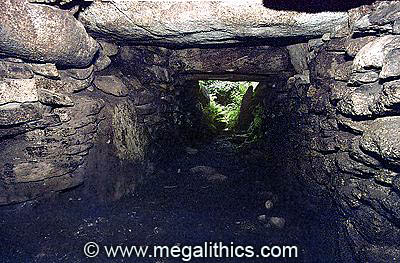
 |
Photo Gallery |
|
Panoramas |
||
3D Vision |
||
| SW 72803 30038 (GPS 20min, SW Lintel). | |
| Visited June 2003 |
Trewardreva Fogou is situated about 1km
north of Constantine and around 100m SE of a secondary road opposite the gates to Trewardreva Hall. The fogou structure is not completely buried below ground level and consequently there is a noticable "hump" over the length of the passage. The location of the original entrance to the fogou is unknown, but if
it was in keeping with those at other better preserved fogous, it would have been a narrow creepway passage. The modern access to the fogou is now via the opened SW end of the passage, a depressed area extends from the entrance for about 2m and may have originally been part of the passage itself. The entrance is capped by a massive roofstone and, just inside, is flanked by two portal stones, these are modern additions which once bore a metal gate used to
prevent entry to the fogou, remains of the hinges can still be seen embedded in the stones.
The present roofed section of the fogou is a single passage about 8m long running straight to a low opening at the NE end, this opening has been partially blocked with modern stonework. The construction of
this fogou is unusual, all of the other fogous we have visited have
had a typical trapezoidal section, the walls gradually tapering inwards towards the roof, presumably to reduced the distance to be
spanned there, but at Trewardreva the walls are virtually perpendicular. Because of the rectangular section, very large stones have been used to roof the passage, the stones at each end of the passage being particularly massive. We counted nine transverse roof stones, some of these being separated by quite long distances which have been spanned by a second layer of slabs
spanning the inter-stone gaps. Just behind the large roofstone at the NE end is a run of three roofstones that are very slender compared to the others, they
have very angular edges and are also considerably lighter in colour, leading us to wonder
if these are modern replacements. The walls are composed of courses of relatively small stones, but in places there are several large orthostats incorporated at ground level. The passage seems to have an alignment to the midsummer sunrise when viewed from the SW end, although considering the tiny constricted creepway entrances usually found in intact fogous, it seems unlikely that the sunrise would have been visible from the fogou interior.
Known locally as "Piskey's Hall" it is shown on the 1:50000 OS map as "Pixies Hall", piskey being the Cornish equivalent of pixie. A local folktale tells of how farmhands fleeing the field after hearing strange noises emanating from the depths of the fogou were sure that what they had heard were the terrible voices of the angry piskeys within.